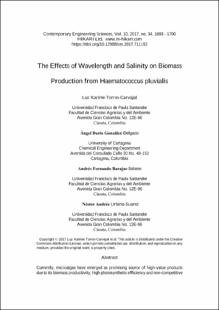The Effects of Wavelength and Salinity on Biomass Production from Haematococcus pluvialis
Artículo de revista
2017-12-24
Contemporary Engineering Sciences
Bulgaria
Currently, microalgae have emerged as promising source of high-value products
due to its biomass productivity, high photosynthetic efficiency and non-competitive environment for growth. In this work, biomass production from Haematococcus
pluvialis was studied at three salt concentrations (0, 0.45 and 0.9% v/v) and blue,
white and red wavelengths in order to evaluate the effects of these factors on
microalgae growth. A 32
experimental design was performed and its results were
analyzed by Manova test with 95% of reliability. The results obtained suggest that
the best combination for biomass production consists of red wavelength and salt
concentration of 0% v/v with a maximum productivity of 8172.2 mg/mL.
- Ambiente y Vida - GIAV [124]
Descripción:
The Effects of Wavelength and Salinity on Biomass Production from Haematococcus pluvialis.pdf
Título: The Effects of Wavelength and Salinity on Biomass Production from Haematococcus pluvialis.pdf
Tamaño: 614.8Kb
 PDF
PDF
 LEER EN FLIP
LEER EN FLIP
Título: The Effects of Wavelength and Salinity on Biomass Production from Haematococcus pluvialis.pdf
Tamaño: 614.8Kb
 PDF
PDF
 LEER EN FLIP
LEER EN FLIP
















